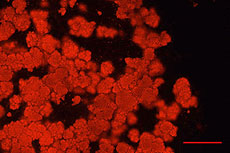July 25, 2005
Moore Foundation gives UCSC a $2.2 million grant for marine microbiology research facility
By Tim Stephens
UCSC has received a $2.2 million grant from the Gordon and Betty Moore Foundation to establish a state-of-the-art facility for marine microbiology research.

Jonathan Zehr, professor of ocean sciences, will be a major user of the new marine microbiology facility.
Photo: rr jones |

Jonathan Zehr's lab has discovered marine microbes that
fix nitrogen, making this key nutrient available to marine
life. Photo shows clusters of nitrogen-fixing unicellular
cyanobacteria, collected from a monitoring station in the
Pacific Ocean and grown in culture.
Photo: Rachel Foster |
The new laboratory, operated by the Institute of Marine Sciences, will support the work of UCSC researchers as well as their collaborators and visiting scientists from other institutions.
"Marine microbiology is an exciting new area of ocean investigation, and it's a real honor that the Moore Foundation has chosen UCSC to set up a top laboratory for research in this important field," said Gary Griggs, director of the Institute of Marine Sciences and principal investigator on the grant.
The grant will provide equipment and staff for a "microbial genomics experimentation and remote sensing laboratory," which will be housed in the Earth and Marine Sciences Building. Jonathan Zehr, professor of ocean sciences, is co-principal investigator and will be a major user of the new facility. The Moore Foundation named Zehr a senior investigator in its marine microbiology initiative last year, supporting his research with a five-year, $4.2 million grant.
Marine microorganisms are not easy to study because they are small and difficult to isolate and grow in the laboratory. Yet vast numbers of them swarm in every cup of seawater.
"There are thousands of important microorganisms out there that we've never gotten into a culture flask. So we need to be able to characterize individual cells or characterize the genetic material directly from the ocean without cultivating the organisms, and this new facility will have equipment to help us do that," Zehr said.
Zehr has made important discoveries about marine microorganisms that "fertilize" the oceans by converting nitrogen gas into a form that other organisms can use, a process known as "nitrogen fixation." He is currently developing genetic probes that can be deployed on moored platforms in the ocean to automatically detect the presence of nitrogen-fixing microbes in the water. This project involves a close collaboration with Chris Scholin, a molecular biologist at the Monterey Bay Aquarium Research Institute (MBARI) in Moss Landing.
"The new facility will strengthen our ties with MBARI and support our collaborative work on a project that is really on the cutting edge of marine microbiology," Zehr said.
Also involved in the project are UCSC oceanographers Raphael Kudela, an associate professor of ocean sciences, and Christopher Edwards, an assistant professor. Kudela and Edwards will use information from the probes and other oceanographic data from remote sensing to try to understand the factors that govern the distribution and large-scale patterns of nitrogen-fixing microorganisms in the ocean.
Ultimately, they hope to develop computer models that can use information from ocean monitoring and remote sensing to make predictions about the growth patterns of marine microorganisms.
Although relatively little is known about the ocean's microbial communities, researchers have found that they are enormously important to marine ecology, the availability and transformations of key nutrients, and even the global climate.
"Marine microorganisms catalyze all the major biochemical transformations on the planet, they help maintain nutrient availability, and they are also a rich source of genetic information, some of which may be useful for biotechnology," Zehr said.
"There is a lot of interest in marine microbes now, because people have realized that the ocean is a huge untapped resource of genes and microorganisms that we know very little about," he added.
The equipment in the new facility will include a flow cytometer, a sophisticated tool that uses laser beams to characterize single cells as they pass through at high speeds, processing and sorting thousands of cells in just a few seconds. The facility will also have a laboratory for cultivation and genomics experiments, as well as a powerful bioinformatics computer cluster for performing genetic analyses.
In addition to Zehr, researchers in environmental toxicology and other departments at UCSC are also expected to make use of the facility, Griggs said.
"It is a multi-user facility, so it will benefit a lot of people on campus and will also attract visiting scientists to UCSC," Griggs said.
The Gordon and Betty Moore Foundation was established in November 2000 by Intel cofounder Gordon Moore and his wife Betty to create positive outcomes for future generations. The foundation funds outcome-based grants and initiatives to achieve significant and measurable results. Grant making supports the foundation's principal areas of concern: environmental conservation, science, higher education, and the San Francisco Bay Area. The foundation launched its 10-year marine microbiology initiative in April 2004, with the goal of attaining new knowledge regarding the composition, function, and ecological role of microbial communities in the world's oceans.
 Email this story
Email this story
 Printer-friendly version
Printer-friendly version
 Return to Front Page
Return to Front Page